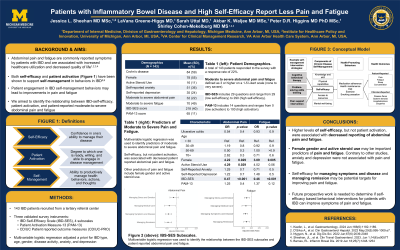Sunday Poster Session
Category: IBD
P0908 - Patients with Inflammatory Bowel Disease and High Self-Efficacy Report Less Pain and Fatigue
Sunday, October 27, 2024
3:30 PM - 7:00 PM ET
Location: Exhibit Hall E

Has Audio

Jessica L. Sheehan, MD, MSc
University of Michigan
Ann Arbor, MI
Presenting Author(s)
Jessica L. Sheehan, MD, MSc1, LaVana Greene-Higgs, MD1, Sarah Uttal, MD2, Akbar Waljee, MD, MS1, Peter Higgins, MD1, Shirley Cohen-Mekelburg, MD, MS2
1University of Michigan, Ann Arbor, MI; 2Michigan Medicine, Ann Arbor, MI
Introduction: Patients with inflammatory bowel disease (IBD) commonly experience pain and fatigue. These symptoms often persist despite control of active inflammation, making their treatment challenging. Both self-efficacy (a patient’s confidence in their ability to perform certain behaviors) and patient activation (the degree to which a patient is ready, willing, and able to engage in disease management) have been shown to support self-management and reduce the daily life impact of IBD. We aimed to understand if increased self-efficacy and patient activation were also associated with less pain and fatigue.
Methods: We identified patients with IBD from a single tertiary referral center to complete a survey comprised of the IBD Self-Efficacy Scale (IBD-SES), Patient Activation Measure (PAM-13), and Crohn’s disease and ulcerative colitis patient report outcome (CD-PRO/UC-PRO) measures. We separately examined the association between self-efficacy, patient activation, and symptoms of moderate-to-severe abdominal pain, joint pain, and fatigue using logistic regression models and adjusting a priori for IBD type, age, gender, active corticosteroid use, self-reported anxiety and depression, and frequency of diarrhea.
Results: A total of 143 patients completed the survey for a response rate of 22%. Most participants (59%) had Crohn’s disease, 55% were female, 11% were actively taking corticosteroids, 36% reported anxiety, and 24% reported depression. The mean IBD-SES score was 218 (SD 40, range 29-290) and the mean PAM-13 score was 65 (SD 11, range 0-100) . Moderate-to-severe abdominal pain, joint pain, and fatigue were reported in 22%, 31%, and 49% of participants, respectively. Higher self-efficacy, but not patient activation, was associated with a lower likelihood of moderate-to-severe abdominal pain (odds ratio [OR] 0.51, p = 0.003; OR 1.3, p=0.3, respectively), joint pain (OR 0.63, p = 0.025; OR 1.2, p=0.5, respectively), and fatigue (OR 0.49, p = 0.003; OR 1.4, p=0.1, respectively). Female gender and active corticosteroid use were also associated with increased pain and fatigue.
Discussion: Moderate-to-severe pain and fatigue are commonly reported by patients with IBD, but are less likely to be reported by patients with higher self-efficacy for performing IBD-specific tasks. Future prospective work is needed to determine if self-efficacy based behavioral interventions for patients with IBD can improve symptoms of pain and fatigue.
Disclosures:
Jessica L. Sheehan, MD, MSc1, LaVana Greene-Higgs, MD1, Sarah Uttal, MD2, Akbar Waljee, MD, MS1, Peter Higgins, MD1, Shirley Cohen-Mekelburg, MD, MS2. P0908 - Patients with Inflammatory Bowel Disease and High Self-Efficacy Report Less Pain and Fatigue, ACG 2024 Annual Scientific Meeting Abstracts. Philadelphia, PA: American College of Gastroenterology.
1University of Michigan, Ann Arbor, MI; 2Michigan Medicine, Ann Arbor, MI
Introduction: Patients with inflammatory bowel disease (IBD) commonly experience pain and fatigue. These symptoms often persist despite control of active inflammation, making their treatment challenging. Both self-efficacy (a patient’s confidence in their ability to perform certain behaviors) and patient activation (the degree to which a patient is ready, willing, and able to engage in disease management) have been shown to support self-management and reduce the daily life impact of IBD. We aimed to understand if increased self-efficacy and patient activation were also associated with less pain and fatigue.
Methods: We identified patients with IBD from a single tertiary referral center to complete a survey comprised of the IBD Self-Efficacy Scale (IBD-SES), Patient Activation Measure (PAM-13), and Crohn’s disease and ulcerative colitis patient report outcome (CD-PRO/UC-PRO) measures. We separately examined the association between self-efficacy, patient activation, and symptoms of moderate-to-severe abdominal pain, joint pain, and fatigue using logistic regression models and adjusting a priori for IBD type, age, gender, active corticosteroid use, self-reported anxiety and depression, and frequency of diarrhea.
Results: A total of 143 patients completed the survey for a response rate of 22%. Most participants (59%) had Crohn’s disease, 55% were female, 11% were actively taking corticosteroids, 36% reported anxiety, and 24% reported depression. The mean IBD-SES score was 218 (SD 40, range 29-290) and the mean PAM-13 score was 65 (SD 11, range 0-100) . Moderate-to-severe abdominal pain, joint pain, and fatigue were reported in 22%, 31%, and 49% of participants, respectively. Higher self-efficacy, but not patient activation, was associated with a lower likelihood of moderate-to-severe abdominal pain (odds ratio [OR] 0.51, p = 0.003; OR 1.3, p=0.3, respectively), joint pain (OR 0.63, p = 0.025; OR 1.2, p=0.5, respectively), and fatigue (OR 0.49, p = 0.003; OR 1.4, p=0.1, respectively). Female gender and active corticosteroid use were also associated with increased pain and fatigue.
Discussion: Moderate-to-severe pain and fatigue are commonly reported by patients with IBD, but are less likely to be reported by patients with higher self-efficacy for performing IBD-specific tasks. Future prospective work is needed to determine if self-efficacy based behavioral interventions for patients with IBD can improve symptoms of pain and fatigue.
Disclosures:
Jessica Sheehan indicated no relevant financial relationships.
LaVana Greene-Higgs indicated no relevant financial relationships.
Sarah Uttal indicated no relevant financial relationships.
Akbar Waljee indicated no relevant financial relationships.
Peter Higgins: AbbVie – Grant/Research Support. Connectome Coordination Facility – Grant/Research Support. GI Health Foundation – Consultant. Imedex – Consultant. Lilly – Consultant. National Institute of Health and Takeda – Grant/Research Support. Pfizer – Consultant. Takeda – Consultant. Vindico Medical Education – Consultant.
Shirley Cohen-Mekelburg indicated no relevant financial relationships.
Jessica L. Sheehan, MD, MSc1, LaVana Greene-Higgs, MD1, Sarah Uttal, MD2, Akbar Waljee, MD, MS1, Peter Higgins, MD1, Shirley Cohen-Mekelburg, MD, MS2. P0908 - Patients with Inflammatory Bowel Disease and High Self-Efficacy Report Less Pain and Fatigue, ACG 2024 Annual Scientific Meeting Abstracts. Philadelphia, PA: American College of Gastroenterology.
